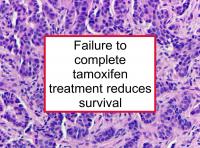Tamoxifen treats estrogen receptor positive (ER+) breast cancer by interfering with a tumor's ability to use estrogen. However, the resulting body-wide estrogen deficiency can cause an increase in vasomotor (hot flashes, night sweats), genitourinary, sexual dysfunction), and musculoskeletal (joint pain, fractures) symptoms, among others.
These side effects cause a large minority of women not to finish five years of scheduled treatment. On the other hand, unpleasant tamoxifen-related symptoms are a sign that the treatment is working and should be continued. Women with side effects were found to have better breast cancer-free survival compared to those with nonspecific or no side effects in one study. For example, women with vasomotor symptoms had a 27% lower risk of recurrence. Now a new study has reported that failure to take tamoxifen as prescribed reduces survival during the first three years.
Latest research finds Tamoxifen nonadherence reduces survival
The study referenced above was designed to investigate the effect of nonadherence to tamoxifen treatment on short-term distant disease-free survival. The study included 1,177 premenopausal women already participating in a large prospective study (CANTO/NCT01993498). The authors used blood tests to assess compliance with treatment, defining nonadherence as a tamoxifen serum level < 60 ng/mL. This was measured one year after the start of the original tamoxifen prescription. The authors also collected data concerning self-reported nonadherence to using semi-structured interviews.
A total of 188 (16%) of the participants were found to have serum levels of tamoxifen below the adherence threshold at the one-year mark. This was higher than the 12% self-reported nonadherence rate.
After approximately three years from the start of the original tamoxifen prescription, nonadherent women were found to have significantly shorter distant disease-free survival (i.e., with no distant recurrence or death). In the nonadherent group, 89.5% of women were alive without distant recurrences compared to 95.4% in the adherent group.
The authors conclude that therapeutic drug monitoring may be useful in identifying patients who are not taking tamoxifen as prescribed and are therefore at risk for poorer outcomes. Interventions to improve patient adherence are needed, according to the authors.
Please see our article on endocrine treatment for more information.
